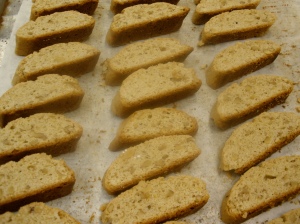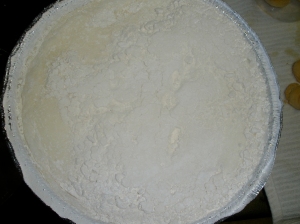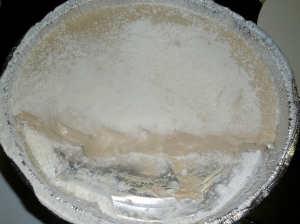Posts Tagged ‘macaroons’
- In: Baking | Cookies | Culinary School
- Leave a Comment
Today was all about petites fours. I always thought these were very fancy, very small dessert preparations so I never tried to make them them. They always seemed so hard since they were so small and delicate looking. Now that I learned what they are, I’ve come to realize I’ve been making these for years! Small cookies, rainbow cookies, mini-cakes can all be considered petites fours. Technically, the term means “little ovens”. Any petite four was basically a small item that can be cooked in the oven using residual heat after a long day of cooking other items. They are meant to be about the size of a quarter and consumed in one bite.
We learned there are three main categories of petites fours. One is called Sec, which means dry. These tend to be cookie type preparations, like a butter cookie (think about those cookies from the Italian bakery that are dry, but great dunked into a cup of coffee) or a rainbow cookie. These are made ahead of time, baked and stored without any decrease in quality. Essentially, there is a staging component to the preparation of these petites fours.
Another variety is called Frais, which means fresh. These have components that have to be made at the last minute. For example, a miniaturized version of a fresh fruit tart could be a Frais petites four. The pate brisee for these should be baked ahead of time. The pastry cream can be made a day or two before you assemble the final tarts. The fruit should be the freshest possible and should be cut as close to service as possible. Assembly of each tart should also take place close to service so that the tart crust remains flaky and delicious. I strongly suspect that Marshmallows fall into this category, since they do not have a very long shelf-life.
The next variety of petites fours is called Glace, which means glazed. These are your chocolate dipped strawberries or other chocolate dipped fruit or chocolate truffles. These also include glazed mini-cakes with jam in the layers. We were also told that petites fours are technically different from BonBon’s but I don’t quite know how. (Anyone know about this?) Once we were enlightened about the variety of different petites fours we went on to make our items of the day: Spritz Cookies, Macaroons, Biscotti, Butternut Crunch, and Marshmallows.
The biscotti and macaroons were delightful and delicious. Flavorful, sweet and cute! I didn’t try the butternut crunch. It just looked too brittle to me. I also think they will be more appealing when glazed with chocolate, which we will be doing next week. The marshmallows were the highlight! I’ve never made fresh marshmallows and I was excited! They’re very simple. We just combined egg whites, sugar, corn syrup, water and gelatin and whisked them over a double boiler. Once they reached 160 degrees (to ensure the eggs were cooked) we put them in a mixer until thick and fluffy. They then were put into a mold and allowed to set. Our class made plain marshmallow, lemon, coffee and lime flavored marshmallows. The lemon was sweet and tangy. The lime reminded me of a key-lime pie. And the coffee had really good coffee flavor and since it was so sweet and creamy I thought I was having a cafe con leche. I did manage to sneak in some shots while everything was cooling.

Biscotti

Biscotti

Marshmallows

Coffee Marshmallow
Who can argue with cookies, bite-sized cookies and cakes or chocolate dipped anything? I think I’ve found my niche in petites fours!
We also prepared for our first quiz in pastry. We were told what questions to expect, so now I just have to figure out the answers. Here’s an idea of all the things we’re expected to know now that we’re in the pastry world.
- What are the folds used for puff pastry and croissants?
The letter fold or “threefold” fold is used for croissants. The book fold or “doubleturn” fold is use for puff pastry. - What are 3 things unique about bagels?
Bagels are poached before baking. Bagels are bench proofed for 10 minutes. This is done after the shaping and before poaching. Bagles are pre-shaped into a log before being shaped into their characteristic ring shape. - Describe the method for making brioche dough.
This is a two stage method for making dough. To prepare the levain dissove yeast into luke warm milk. Combine the yeast and milk mixture with flour. Cover and ferment this mixture until doubled in size. The flour is a percentage of the total flour in the dough. To make the pate, combine butter sugar and salt in a mixing bowl. In a mixer, cream these components until well blended. Beat in the eggs and egg yolks one at a time. It is important to do this slowly or you will break the emulsion. Add the rest of the flour until it is absorbed then change to a dough hook. Add the levain and beat until the dough is smooth and elastic. You should be able to pick up all the dough and see how it stretches to determine if you have gluten. Once it is ready, place the dough in a plastic bag, sprayed with non-stick spray and place in the refrigerator to slowy ferment (retard). Punch the dough and shape it into brioche a tete or other shapes you desire. - What are the different tart doughs and how are they made? What fillings are suitable for each dough?
- Describe the method and ingredients used for poaching fruit.
| Pate Brisee | Pate Sucre | |
| Dry Ingredients | AP Flour, Cake flour, salt, sometimes baking powder | AP Salt, Sugar, Baking Powder |
| Fat | Butter: Should be large pieces that are cold. The cold makes it flaky! You can also use larde, shortening or suet. | Butter: This is used to create a homogeneous, mealy mixture. |
| Liquid | Water, milk, or cream. | Egg |
Pate brisee should be blind baked and then filled since it can not tolerate a moist filling. Baking it with a moist filling will cause the crust to become soggy instead of flaky. Pate sucree can be used for sweet or savory preparations. If using for savory do not include the sugar. This is a sturdier dough and can be baked with a moist filling such as a frangipane.
Peel, halve and core pears and place in acidulated water to prevent browning. Place pears in a a sauce pan and add enough wine and water to cover the pears by 1 inch of liquid. Add sugar and any spices to flavor the pears. You can use vanilla bean, all spice, or clove. Cut a round of parchment to fit inside the sauce pan and cover the pears with the paper. This will help to ensure they are kept submerged in the liquid. Bring to a boil and then reduce to a gentle simmer. Cook pears until softened. Cool the pears in their poaching liquid in an ice bath. The syrup acts as a flavoring agent as well as a preservative.